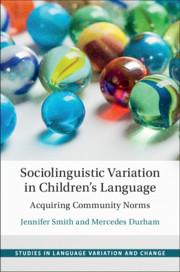Sociolinguistic Variation in Children's Language
How we vary our speech is fundamental in signalling who we are, where we're from and where we're going. How and when does such variation arise? Here, leading experts Jennifer Smith and Mercedes Durham address this question through a sociolinguistic analysis of the speech of preschool children in interaction with their primary caregivers. Bringing together two fields of linguistic research - variationist sociolinguistics and first language acquisition - the study focusses both qualitative and quantitative analysis of a range of variables to show when and how variation is acquired by young children, and the effect the caregiver's interaction has on this process. In doing so, they tackle a fundamental question in language research: when and how do children acquire the highly complex patterns of variation widely attested in adult speech?
- Focuses on a comprehensive range of features that provides a complete picture of the acquisition of variation.
- Analyses an extensive database of vernacular speech arising from caregiver/child interaction in the earliest years of language development.
- Provides a wealth of real-life examples of caregiver/child interaction, not readily available elsewhere
Reviews & endorsements
‘For scholars interested in language acquisition, local linguistic variation, style shifting, or the idiosyncratic charms of tiny children, Smith & Durham offer an intriguing text for intellectual consumption.’ Rachel Sona Reed, Language in Society
Product details
June 2019Hardback
9781107172616
232 pages
235 × 156 × 15 mm
0.51kg
Available
Table of Contents
- 1. Introduction
- 2. Methodology
- 3. Getting to grips with the data
- 4. Lexical variables
- 5. Lexical-phonological variables
- 6. Phonetic variables
- 7. Morphosyntactic variables
- 8. The acquisition of sociolinguistic variation: synthesising our findings.





